One of the more common questions that we hear as an equipment manufacturer is, “what’s the best way to fill my product?” Of course, there are a range of equipment options, as well as taking into consideration items related to project specifics, i.e. required rate, product characteristics, container configuration, budgetary parameters, and fill volumes to name a few areas.
Today, we are going to take a unique look at things and review the term “filling action”. An incredibly important, interesting, and sometimes overlooked aspect of liquid packaging. So, whether you have a water-like, foamy, or a viscous type product, what’s the best ‘filling action’ to successfully fill your product? Let’s dive in and learn more.
Let’s define ‘Filling Action’
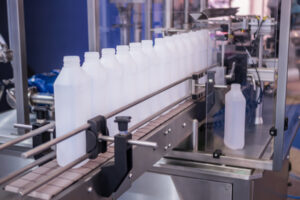
No matter what type of liquid product you have, you might be using a liquid filing machine to dispense your product into containers. As your container travels down the conveyor to be filled underneath the nozzles, you may require a ‘filling action’ best suited for your type of liquid product and/or container.
The ‘filling action’ refers to what type of action will your nozzles perform during the actual filling of liquid product into containers. Some nozzle arrangements will have them move slightly, some will remain still, some will encompass a great deal of action or movement. There are three main types of filling actions that we will discuss in this article:
- Static filling
- Bottom-Up filling
- Locate filling
Depending on your product, one of these filling actions will be best suited for your overall application.
Static Filling
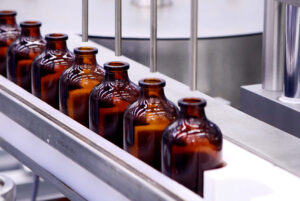 With Static filling, the nozzle/s remains stationary throughout the entire fill cycle – the nozzle/s will not move in this arrangement. Your containers will be moved into position by hand or some automated process, such as a conveyor system or positioning pins/arms.
With Static filling, the nozzle/s remains stationary throughout the entire fill cycle – the nozzle/s will not move in this arrangement. Your containers will be moved into position by hand or some automated process, such as a conveyor system or positioning pins/arms.
Semi-automatic handheld filling machines will typically have operators manually moving nozzles from bottle to bottle for the filling action, or using a nozzle bracket to hold nozzle/s in place with no option of movement. Technicians will usually place the containers into position, often guided by fixtures or bottle locators stationed on to a surface.

When discussing next step solutions and higher levels of equipment automation, that’s when different types of filling actions really start to come into the equation. These systems will encompass linear or rotational transfer mechanisms, such as a starwheel, responsible for moving containers into the proper position under the nozzles. Therefore, the pros/cons of a filling action within these solutions becomes a reality when talking about product type and project parameters.
Best Applications for Static Filling
Static filling is most ideal for applications where the product is free flowing. That means the liquid product does not have properties that could easily create spills or interrupt the flow of production. It is also ideal for speed. This arrangement is most common and usually produces a higher rate per minute than the other types of filling actions, but it does have limitations when dealing with different types of liquid products.
Bottom-Up Filling
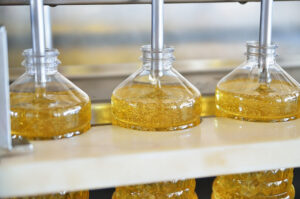 In Bottom-Up filling, the nozzle/s will lower into the container, stopping just short of the bottom of the container (½” to 1” from the bottom), and start dispensing as the nozzle/s slowly raises, continuing to dispense, and reset to its original position when complete. The nozzle/s are controlled by either a mechanical or pneumatic operation – mostly servo-motors within contemporary configurations.
In Bottom-Up filling, the nozzle/s will lower into the container, stopping just short of the bottom of the container (½” to 1” from the bottom), and start dispensing as the nozzle/s slowly raises, continuing to dispense, and reset to its original position when complete. The nozzle/s are controlled by either a mechanical or pneumatic operation – mostly servo-motors within contemporary configurations.
It is important to note, once filling begins the nozzle/s will rise in unison with the product level. The idea here is to minimize the vertical drop of the product. Upon completion of the fill, the nozzle/s will pull out from the container to a particular height above the containers. This will allow for new containers to be moved into position, indexed, and filled. The process then repeats itself in a continuous manner.
Similar to the Static filling action, the Bottom-Up technique can be found across semi-automatic handheld fillers, inline filling lines, as well as fully automated, integrated systems.
Best Applications for Bottom-Up Filling
Bottom-Up filling is often used in applications where undesirable filling properties are present, i.e. liquids that could cause foaming, splashing, or spilling. In some instances, extremely thick types of product where air-pockets could be created with a standard, static type fill technique is best served with a Bottom-Up filling action. Any of these product issues could slow the production process down considerably, or even cause complete stoppage due to fill errors.
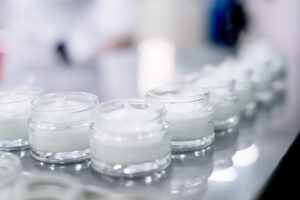
By reducing the amount of freefall and velocity of the liquid product filling into the container, the end result is a more consistent fill that is less likely to interrupt the liquid from it’s natural state.
Viscous cosmetics and personal care creams, gels and some lotions will utilize Bottom-Up filling as well. If you were to use a Static fill for some creams, gels and lotions, the fill action into containers runs the risk of poor product settlement. The ability to control the speed of the Bottom-Up fill/motion helps break the final string of some products.
Bottom-Up filling can also be used to help will some fill aesthetics. Some beauty and cosmetic manufacturers often want their creams to have a pleasing shape and aesthetic “whipped top” at the top of their containers. This pleasing visual aesthetic can be achieved with Bottom-Up filling.
You can also see the Bottom-Up filling technique used in some specialty chemical applications as well.
Locate Filling
In our final filling action description, we’ll talk about the Locate filling technique. In Locate filling, nozzle/s locator devices are used to position, grab, and/or center containers so the nozzle/s will 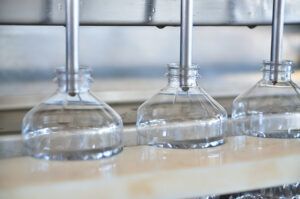 be located directly above the neck/opening of the container before dropping the tip/s of the nozzle/s slightly into the container. The nozzle/s are then positioned just inside the container but not as far down as Bottom-Up filling technique.
be located directly above the neck/opening of the container before dropping the tip/s of the nozzle/s slightly into the container. The nozzle/s are then positioned just inside the container but not as far down as Bottom-Up filling technique.
Best Applications for Locate Filling
Locate filling provides some of the added benefits of the Bottom-Up filling style, with less loss of speed associated with the Bottom-Up technique. Locate filling is best for applications in which the liquid product benefits from the least amount of product travel in the container, minus requiring a full Bottom-Up fill.
Interesting Takeaways…
The Static filling option is the most commonly used fill action/nozzle arrangement across liquid packaging designs. It’s an efficient, quick and easy setup for the user that satisfies a wide variety of applications.
When discussing Bottom-Up filling, there are some initial engineering tasks that need to be accomplished to make sure the system is operating accurately and efficiently as it pertains to the Bottom-Up filling action (engineering design and testing procedures). Given that within this setup, the nozzle/s will be moving a great deal, it is critical that the action be perfectly set to consistently repeat in timing and placement.
Some tend to think the Bottom-Up filling action is a “slower action”. This is not always true. However, you do have to pause for the nozzles to enter/exit the containers at various points of the filling cycle. While this process is longer than the Static or Locate filling action, you can still achieve enhanced speeds due to negating the impact of foaming, splashing, and spilling of certain liquid products.
If/when possible, be sure to request a product test to help determine which filling action is best for your liquid filling project. We recommend you talk with specialists in liquid filling systems to assist with these types of tests.
Specialists in Liquid Filling Systems
For over 70 years, FILAMATIC has been providing a wide range of liquid filling systems to the packaging industry. We create flexible, customized solutions for every stage of your business growth. Whether you require a single handheld filling machine, a complete turnkey fill-cap-label solution, or a fully automated, integrated filling system, we have the liquid filling experience to ensure your satisfaction is exceeded.
For more information on liquid filling, capping and labeling solutions, please call 866.258.1914 or email info@filamatic.com.
